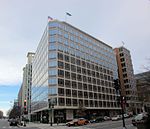World Bank Infoshop

The InfoShop was a non-profit bookstore in Washington, D.C., run by the World Bank specializing in "economics and international development ... current events, history, banking and finance, plus travel guides, reference books and international fiction", including discounted and remaindered books. The shop offered discounts to students, and to customers who worked in government, NGOs, or the World Bank. The shop also sold children's books, world music CDs, books and audio for learning languages, gifts, and stationery supplies with the World Bank logo.From 2005, the InfoShop featured public programs with "up-and-coming and internationally known authors." In 2006, the InfoShop became home to the first installation of the beta version of the Espresso Book Machine. By 2010 World Bank Publications (the World Bank Group's publishing organization) was recovering roughly two-thirds of the costs of operating the store through sales, in part because the publications of the World Bank are also made available free of charge online.In October 2012, Occupy D.C. blockaded the doors of the InfoShop as a part of a protest against the World Bank, Verizon, Wells Fargo, and PNC Bank.The Infoshop closed in October 2016 after 20 years of operation.
Excerpt from the Wikipedia article World Bank Infoshop (License: CC BY-SA 3.0, Authors, Images).World Bank Infoshop
Pennsylvania Avenue Northwest, Washington
Geographical coordinates (GPS) Address Nearby Places Show on map
Geographical coordinates (GPS)
| Latitude | Longitude |
|---|---|
| N 38.899 ° | E -77.041 ° |
Address
Pennsylvania Avenue Northwest 1730
20006 Washington
District of Columbia, United States
Open on Google Maps





